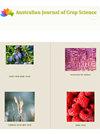Phosphorus fertilizer with increased efficiency affects soybean yields
Q3 Agricultural and Biological Sciences
引用次数: 0
Abstract
Phosphate fertilization is an important tool for achieving high yields in soybean, especially in tropical soils where phosphate fertilization efficiency is low. Fertilizers with improved efficiency, such as polymer-coated fertilizers, are one of several strategies to increase P fertilization efficiency. The objective of this study was to evaluate plant growth, leaf P content, soybean yield, and P fertilization efficiency in different seasons in response to P rates and sources. A factorial experiment (2 x 4) + 1 using two P sources (monoammonium phosphate (MAP) and Policote-coated MAP), four P rates (40, 80, 120, and 160 kg P2O5 ha-1), and the control (no P fertilization) was conducted with soybean in the 2016-2020 seasons. Phosphate fertilization increased soybean yield and was affected by P rates and sources. Soybean yield increased from 1464.7 kg ha-1, 468.4 kg ha-1, and 2297.3 kg ha-1 without P fertilization to 3,638.5 kg ha-1, 3,682.1 kg ha-1, and 3,856.7 kg ha-1, respectively, when MAP was applied at 158.0, 125.3, and 160 kg ha-1 P2O5, while when Policote coated MAP, the maximum productivity was 3,950.3 kg ha-1, 4,380.5 kg ha-1 and 4,343.0 kg ha-1 with 159.0, 160.0 and 140.1 kg ha-1 P2O5, respectively, in 2017/2018, 2018/2019 and 2019/2020 seasons. Increasing phosphate fertilizer rates decreased agronomic P use efficiency (APUE), which was mitigated by P-coated fertilizer (fertilizer with improved efficiency). Lower APUE was observed in the 2019/2020 season, likely as a result of residual effects from previous phosphate fertilizer applications磷肥效率提高影响大豆产量
磷肥是实现大豆高产的重要手段,特别是在磷肥效率较低的热带土壤中。聚合物包膜肥料是提高磷肥效率的几种策略之一。本研究旨在评价不同季节植物生长、叶片磷含量、大豆产量和施磷效率对施磷量和施磷源的响应。采用2 × 4 + 1因子试验,采用2种磷源(磷酸一铵(MAP)和包覆磷酸一铵(Policote-coated MAP), 4种施磷量(40、80、120和160 kg P2O5 hm -1)和对照(不施磷肥),在2016-2020季以大豆为试验材料。施磷肥能提高大豆产量,并受施磷素量和磷素来源的影响。在2017/2018、2018/2019和2019/2020季节,施用158.0、125.3和160 kg ha-1 P2O5时,MAP的大豆产量分别从未施用磷肥的1464.7 kg ha-1、468.4 kg ha-1和2297.3 kg ha-1增加到施用159.0、125.3和160 kg ha-1 P2O5时的3,638.5 kg ha-1、3,682.1 kg ha-1和3,856.7 kg ha-1,而施用Policote时,在159.0、160.0和140.1 kg ha-1 P2O5时,MAP的最大产量分别为3,950.3 kg ha-1、4,380.5 kg ha-1和4,343.0 kg ha-1。磷肥施用量的增加会降低磷素农艺利用率(APUE),磷素包覆肥(效率提高肥)可以缓解这一影响。2019/2020季APUE较低,可能是由于之前磷肥施用的残留效应
本文章由计算机程序翻译,如有差异,请以英文原文为准。
求助全文
约1分钟内获得全文
求助全文
来源期刊

Australian Journal of Crop Science
农林科学-农艺学
CiteScore
1.20
自引率
0.00%
发文量
75
审稿时长
3.5 months
期刊介绍:
Information not localized
 求助内容:
求助内容: 应助结果提醒方式:
应助结果提醒方式:


